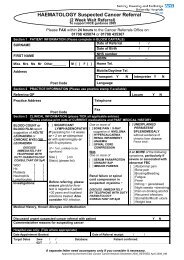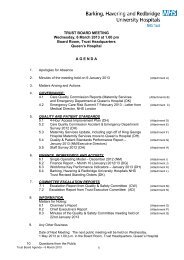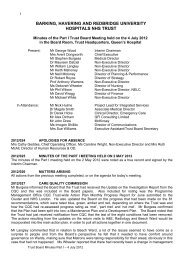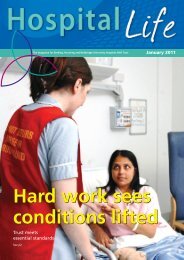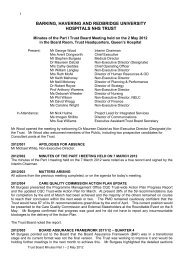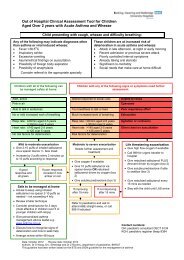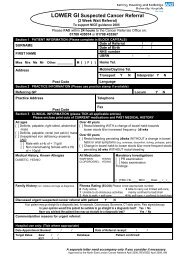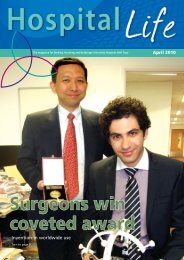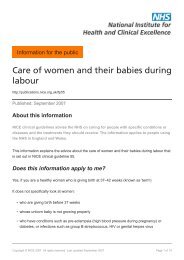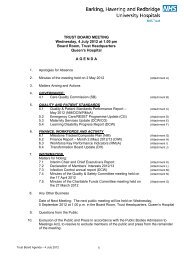Neurosurgery patient information - thoracic discectomy
Neurosurgery patient information - thoracic discectomy
Neurosurgery patient information - thoracic discectomy
Create successful ePaper yourself
Turn your PDF publications into a flip-book with our unique Google optimized e-Paper software.
Your operation: Thoracic Discectomy<br />
Prolapsed intervertebral disc<br />
The normal intervertebral disc acts as a shock absorber between neighbouring vertebrae –<br />
the building blocks of the spine. Degenerative or wear and tear changes in the spine can<br />
cause the soft inner core of a disc to bulge – or prolapse – outside of its tough outer ring. In<br />
the spine of the chest – the <strong>thoracic</strong> spine – this can cause a band of pain around the body<br />
by causing pressure on a spinal nerve or weakness of the legs by causing pressure on the<br />
spinal cord. Most <strong>thoracic</strong> disc prolapses do not require surgical treatment. However in<br />
<strong>patient</strong>s with severe pain that does not respond to other therapies and in others with<br />
worsening leg weakness, surgery to take the pressure off the nerves or spinal cord may be<br />
required.<br />
The operation : Thoracic Discectomy<br />
There are two routes employed to reach a prolapsed intervertebral disc in the <strong>thoracic</strong> spine<br />
without disturbing the delicate spinal cord.<br />
Costotransversectomy<br />
Through a curved cut on the back a hands-width away from the midline, a rib is exposed and<br />
followed towards the spine before its end is removed.<br />
Thoracotomy<br />
Through a cut on the side of the chest along the line of a rib, the cavity of the chest is<br />
opened. The anaesthetist will then allow the lung on that side to collapse before the end of a<br />
rib is removed.<br />
The choice of operative route will depend on the exact position of the disc prolapse relevant<br />
to the spinal cord. Whichever is chosen, once the disc is exposed it can then be drilled<br />
before being carefully separated from the nerves of the spine.<br />
Aim of surgery<br />
The main aim of surgery is to take the pressure off the spinal cord in order to halt the<br />
progression of leg weakness. Although this weakness may improve to some degree it is<br />
unusual for it to return to normal. Band like pain around the body may improve but back<br />
pain is unlikely to do so. This is because the underlying wear and tear change will remain.<br />
Risks of surgery<br />
As with all spinal surgery damage to the spinal cord leading to numbness or weakness below<br />
the operated level is an outside possibility. This includes a very small chance of paralysis of<br />
the legs or problems with bladder or bowel control. Bleeding may occur during the operation<br />
and require blood transfusion. Infection may occur in the wound or in the disc space<br />
requiring antibiotic treatment. Spinal fluid may leak from the wound requiring bed rest, extra<br />
stitches or a drain to by-pass the leak. Very rarely the small amount of the spine removed<br />
during the surgery may be sufficient to affect the stability of the spine and in this event<br />
further surgery may be required.<br />
When a thoracotomy is required as the surgical route there is a risk of blood, air, spinal fluid<br />
or infection collecting in the cavity of the chest after the operation and interfering with<br />
breathing. A drain is usually left in the chest after the surgery to minimise these risks.<br />
Although these are major operations the risk to life is still very small.<br />
After the surgery<br />
If a chest drain is required it will be removed when it no longer drains a large volume of fluid.<br />
You will then be able to mobilise freely. Your pain will be controlled with pain-killing<br />
medication. You will be allowed home as soon as your mobility and level of pain safely<br />
permit it – probably about 3-5 days after surgery , a little longer if a thoracotomy is needed.<br />
You should be able to return to work in 4-6 weeks, longer if you have a very physical job.<br />
You will be followed up in the out <strong>patient</strong> clinic in 2-3 months.
Figure 1<br />
A CT scan showing a large <strong>thoracic</strong> disc prolapse reducing the size of the spinal canal



![[4] Biopsy Leaflet.pub - Barking, Havering and Redbridge University ...](https://img.yumpu.com/51285530/1/190x134/4-biopsy-leafletpub-barking-havering-and-redbridge-university-.jpg?quality=85)

